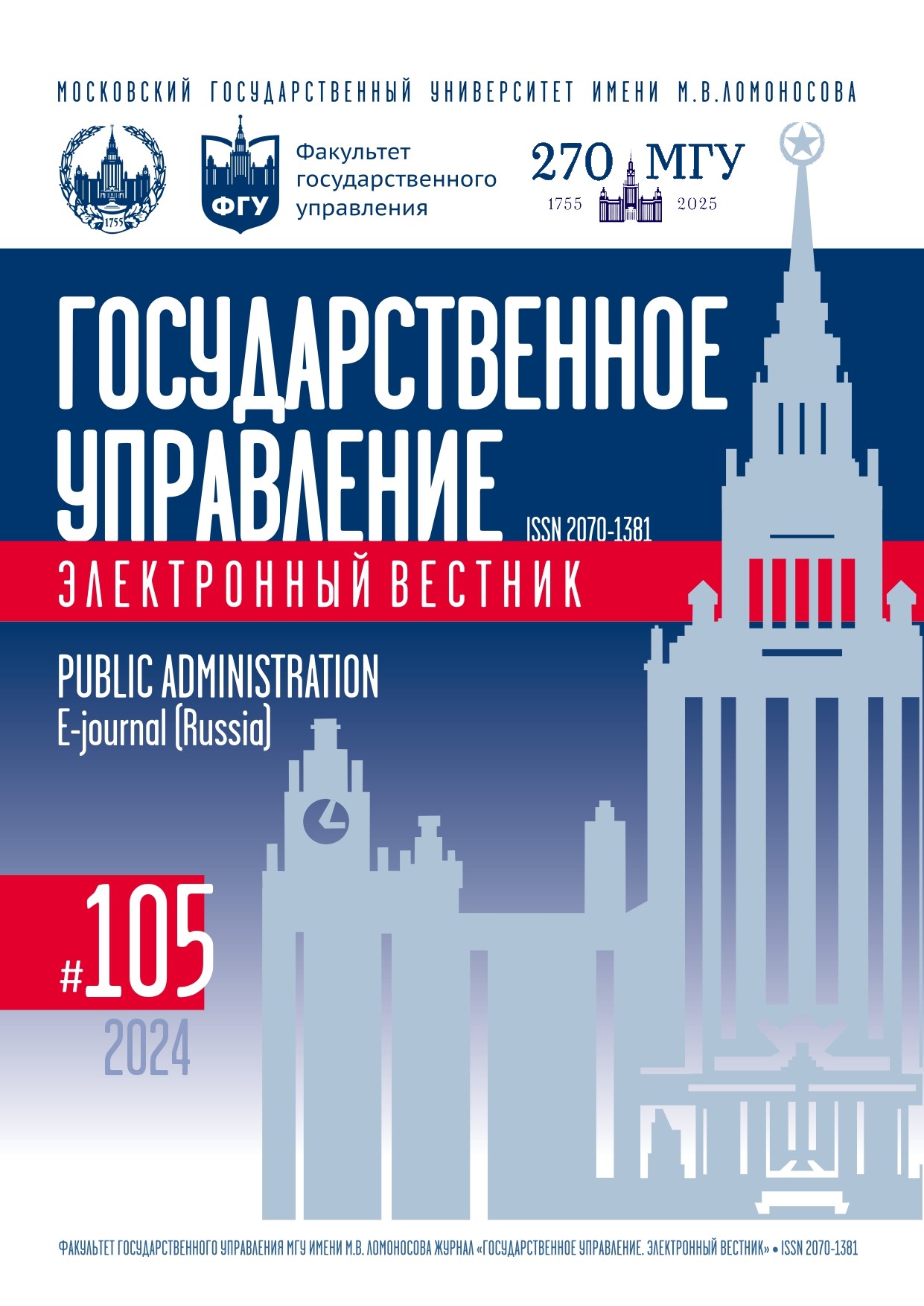Women's Representation in Government Bodies of the Russian Federation in the Period from 1991 to 2023
Keywords:
Women's representation, women in politics, women politicians, gender distribution of power functions, gender, women's political leadership.Abstract
The representation of women in public authorities reflects a number of more general issues related to gender equality, the peculiarities of women's political leadership, women's participation in politics, etc. The purpose of this article was to identify gender proportions in the federal executive authorities and the Federal Assembly of the Russian Federation for the period from 1991 to 2023. The study was conducted by statistical analysis of data presented in open sources, on the websites of the Federation Council, the State Duma, the Government and other public authorities. This article reflects the dynamics of changes in the gender distribution of positions in the field of politics over the period under study. For the analysis, the highest positions of executive and other state authorities of the country were selected, as well as membership in both chambers of the Russian parliament, which made it possible to consider women's representation in positions involving direct decision-making. The study raises the problem of the underrepresentation of women in senior political and elected positions in public administration. According to the results of the study, data on women's representation in government over the past 34 years were systematized. A trend has been identified to increase the representation of women in high-level executive positions. At the same time, the number of women in the Cabinet of Ministers of our country in the entire history of the Russian Federation has not exceeded 11% or two female representatives at the same time. No more than two women at the same time had the opportunity to take the position of Deputy Prime Minister. There are positions that have been held exclusively by men for more than thirty years. The number of women in the country's parliament is also small, but the positive trend here is more pronounced. With a global average of 26.5% female representation, in Russia there are only 18.4% women among the members of both houses of parliament.
References
Айвазова С.Г. Женское движение как ресурс модернизации России // Гендерная реконструкция политических систем. 2004. С. 641–656.
Анкерсмит Ф.Р. Политическая репрезентация / пер. с англ. А. Глухова. Нац. исслед. ун-т «Высшая школа экономики». Москва: Изд. дом Высшей школы экономики, 2012.
Батавина М.А., Ильяшова Ю.А. Гендерная асимметрия как особенность формирования кадрового обеспечения государственной службы // Политика, экономика и инновации. 2021. № 3 (38). С. 1–7.
Воронина О.А. Женский активизм и гендерные исследования в контексте времени // Женское движение в России в XXI веке: уроки и перспективы: сборник материалов Всероссийской науч. конф. с международным участием, Иваново, 23 января 2021 г. 2021. С. 16–25.
Головинов А.В., Головинова Ю.В. Международное измерение гендерного равенства: социально-правовое исследование // Society and Security Insights. 2022. № 3. С. 37–46.
Коростылева Н.Н. Гендерное распределение в системе государственной гражданской службы // Государственная служба. 2015. № 5(97). С. 68–72
Овчарова О.Г. Гендерная асимметрия политики: изменение мировой конфигурации // Южно-российский журнал социальных наук. 2016. № 2. С. 70–81.
Ушакова В.Г. Женское движение в России: вызовы и потенциал в условиях цифрового / информационного общества // Женское движение в России в XXI веке: уроки и перспективы: сборник материалов Всероссийской науч. конф. с международным участием, Иваново, 23 января 2021 г. 2021. С. 51–57.
Цветкова Н.А. Женщины в системе государственного управления и политике России // Развитие российской системы государственного управления: реалии современности, тенденции, перспективы. Сборник научных трудов II международной научно-практической конференции. 2017. С. 240–242
Чернышева Ю.А. Гендерные структуры парламентов России и Франции: общее и особенное // Научное сообщество студентов: междисциплинарные исследования: сб. ст. по мат. XXVI междунар. студ. науч.-практ. конф. 2017. № 15(26). С. 90–95.
Шведова Н.А. Цели устойчивого развития: акцент на женском населении планеты // Женщина в российском обществе. 2023 № 2 С. 3–13.
Швец Л.Г., Шепелева Ю.Л. Гендерный аспект властных отношений: проблемы и направления развития: монография. М.: КРЕДО, 2015.
Шепелева Ю.Л. Гендерная асимметрия в современной политике и перспективы ее преодоления // Молодой ученый. 2014. № 16(75). С. 155–158.
Шепелева Ю.Л. Гендерные аспекты лидерства в рамках политологических исследований // Государственное и муниципальное управление. Ученые записки. 2012. № 4. С. 200–209.
Bektas E., Issever-Ekinci E. Who Represents Women in Turkey? An Analysis of Gender Difference in Private Bill Sponsorship in the 2011–15 Turkish Parliament // Politics & Gender. 2019. Is. 15(4). P. 851–881. DOI: 10.1017/S1743923X18000363
Coscieme L., Fioramonti L., Mortensen L.F., Pickett K.E., Kubiszewski I., Lovins H., McGlade J., Ragnarsdottir K.V., Roberts D., Costanza R., De Vogli R. Women in power: female leadership and public health outcomes during the COVID-19 pandemic // MedRxiv. 2020. DOI: http://dx.doi.org/10.1101/2020.07.13.20152397.
Maity S, Barlaskar U.R. Women's political leadership and efficiency in reducing COVID-19 death rate: An application of technical inefficiency effects model across Indian states // Socioecon Plann Sci. 2022. Vol. 82. Part B. DOI: 10.1016 /j.seps.2022.101263
Markham S. Women as Agents of Change: Having Voice in Society and Influencing Policy. // Women’s Voice, Agency, and Participation Research Series. 2013. No. 5. P. 2–20.
Michele L.S. Pursuing Women’s Interests in Partisan Times: Explaining Gender Differences in Legislative Activity on Health, Education, and Women’s Health Issues // Journal of Women, Politics & Policy. 2016. Is. 37(3). P. 249–273. DOI: 10.1080/1554477X.2016.1188599
Prihatini E.S. Women in Politics // Women in Parliament: Beyond Number / ed. by J. Ballington, A. Karam. Sweden: Trydells Tryckeri AB. 2020. P. 33–47.

